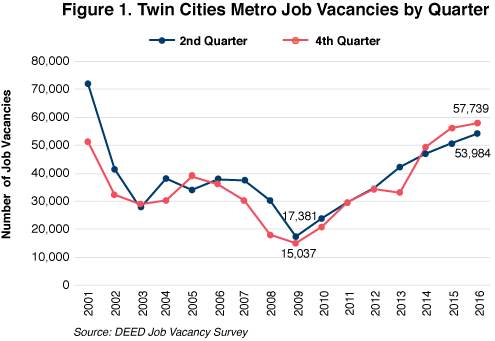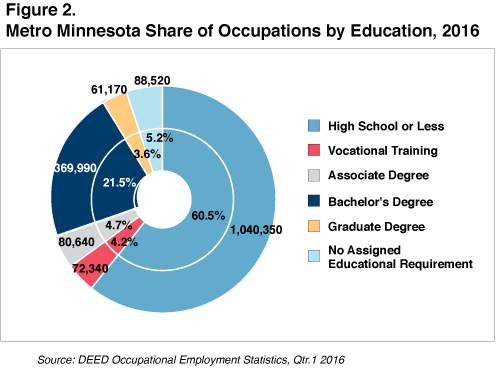
by Tim O'Neill
June 2017
With the labor market tightening up, businesses are increasing wages, offering sign-on bonuses, reimbursing tuition and lowering hiring requirements to attract workers.
The Twin Cities Metro is a driving force for growth in Minnesota, accounting for more than 60 percent of the jobs in the state. In fact, the Metro accounted for two-thirds of the state’s employment growth between 2009 and 2016, equal to nearly 180,000 jobs.1
The Metro shed nearly 96,000 jobs during the Great Recession between 2007 and 2009. From 2009 to 2010, the region was still finding its feet, adding just over 11,000 jobs. Since 2010, however, employment has grown like clockwork, averaging over 28,000 jobs annually.
Geographically, employment growth within the Metro has been uneven. In a tale of two counties, Hennepin has led the charge, accounting for 60 percent of the region’s new jobs between 2009 and 2016. That isn’t surprising, since Hennepin makes up over half of the region’s total employment.
Ramsey County, at one-fifth of the region’s total employment, accounted for only 7 percent of employment growth between 2009 and 2016. Why might this be the case? Watch for future Trends and Employment Review articles to find out.
The fastest job expansion has occurred in Scott and Washington counties, particularly in the last year (see Table 1).
| Twin Cities Metro Employment Trends, Q3 2009 – Q3 2016 | ||||||
|---|---|---|---|---|---|---|
| Area | Number of Establishments | Number of Jobs | 2015-2016 Employment Change | 2015-2016 Employment Change | ||
| Numeric | Percent | Numeric | Percent | |||
| Minnesota | 162,359 | 2,835,325 | 43,705 | 1.6% | 272,869 | 10.6% |
| Twin Cities Metro | 75,969 | 1,709,539 | 28,934 | 1.7% | 179,346 | 11.7% |
| Hennepin County | 36,648 | 903,772 | 17,987 | 2.0% | 107,107 | 13.4% |
| Ramsey County | 12,705 | 328,628 | 278 | 0.1% | 12,788 | 4.0% |
| Dakota County | 9,448 | 186,986 | 3,242 | 1.8% | 18,387 | 10.9% |
| Anoka County | 6,765 | 120,228 | 2,217 | 1.9% | 13,358 | 12.5% |
| Washington County | 5,238 | 82,585 | 2,391 | 3.0% | 13,055 | 18.8% |
| Scott County | 2,917 | 49,507 | 2,860 | 6.1% | 8,663 | 21.2% |
| Carver County | 2,248 | 37,831 | -40 | -0.1% | 5,988 | 18.8% |
| Source: DEED Quarterly Census of Employment and Wages | ||||||
Employment growth by industry sector also has been uneven in the region. Far and away, health care and social assistance has been the largest-growing sector since 2009, gaining over 44,700 jobs. Professional, scientific and technical services comes in a solid second, gaining nearly 29,400 jobs during that time. In a virtual tie for third place, the accommodation and food services sector and construction each gained about 16,000 jobs.
Out of 20 major industry sectors, those four sectors accounted for 60 percent of employment growth between 2009 and 2016. Transforming industries, or those witnessing employment losses between 2009 and 2016, include information; real estate, rental and leasing; and agriculture, forestry, fishing and hunting.
As employment has grown in the Metro, demand for workers has increased. This has led to very low unemployment rates across the region. Unemployment in the Twin Cities sat at 3.5 percent in 2016, representing approximately 57,300 people. To get some perspective, unemployment spiked at 7.4 percent in 2009, which represented approximately 119,200 people. Essentially, the available supply of workers in the region has been halved within seven years.
At the same time, the Metro population is becoming older. According to the U.S. Census Bureau's American Community Survey, the region's population increased by 12 percent between 2005 and 2015, or about 323,800 people. During that same period, however, those 65 and older grew by 49.5 percent, or about 126,200 people. As the population ages, more people will retire, opening up even more jobs in the region.
Like many other regions in Minnesota, steady economic growth, low unemployment and an aging population have combined to create a tight labor market in the Metro. As of fourth quarter 2016, there were only 0.9 unemployed persons for each job vacancy in the region. What's more, the 57,739 vacancies reported during the quarter were the second highest on record (see Figure 1).

See Table 2 to get a sense of which fields have the most demand in the Metro.
| Twin Cities Metro Job Vacancy Survey Results, Qtr. 4 2016 | |||||||
|---|---|---|---|---|---|---|---|
| Industry | Number of Job Vacancies | Percent of Job Vacancies | Percent Part-Time | Requiring Post-Secondary Education | Requiring 1+ Years Experience | Median Wage Offer | Change in Vacancies Q4 2011 – Q4 2016 |
| Total, All Industries | 57,739 | 100.0% | 41% | 36% | 50% | $15.00 | 95% |
| Health Care and Social Assistance | 11,249 | 19.5% | 53% | 47% | 41% | $14.40 | 152% |
| Retail Trade | 8,262 | 14.3% | 67% | 6% | 18% | $11.31 | 81% |
| Accommodation and Food Services | 8,143 | 14.1% | 61% | 0% | 34% | $11.71 | 201% |
| Manufacturing | 4,782 | 8.3% | 18% | 37% | 71% | $15.87 | 91% |
| Administrative and Support Services | 4,741 | 8.2% | 41% | 36% | 44% | $14.98 | 333% |
| Finance and Insurance | 3,131 | 5.4% | 5% | 47% | 80% | $24.22 | 26% |
| Professional and Technical Services | 2,706 | 4.7% | 4% | 91% | 84% | $29.67 | 44% |
| Educational Services | 2,562 | 4.4% | 51% | 59% | 51% | $18.14 | 34% |
| Wholesale Trade | 1,751 | 3.0% | 4% | 42% | 75% | $18.53 | 92% |
| Management of Companies | 1,678 | 2.9% | 22% | 68% | 87% | $25.44 | 4% |
| Construction | 1,621 | 2.8% | 9% | 23% | 49% | $19.46 | 170% |
| Transportation and Warehousing | 1,588 | 2.8% | 40% | 15% | 40% | $15.42 | 100% |
| Real Estate, Rental and Leasing | 1,537 | 2.7% | 0% | 61% | 100% | $29.84 | *4,558% |
| Public Administration | 1,352 | 2.3% | 36% | 53% | 68% | $22.30 | 138% |
| Arts, Entertainment and Recreation | 1,060 | 1.8% | 73% | 20% | 65% | $14.81 | 62% |
| Other Services | 1,043 | 1.8% | 34% | 40% | 26% | $11.97 | -42% |
| Information | 452 | 0.8% | 1% | 84% | 91% | $29.60 | -53% |
| Utilities | 40 | 0.1% | 0% | 75% | 96% | $28.72 | -5% |
| Agriculture | 36 | 0.1% | 66% | 10% | 33% | $11.43 | 6% |
| *Real Estate vacancies were uncharacteristically low during 4th quarter 2011, while reaching a near-record high in 2016.Source: DEED Job Vacancy Survey | |||||||
With an ever-tightening labor market, Metro employers are becoming more creative with hiring. Beyond increasing wages and benefits, offering sign-on bonuses and tuition reimbursement, and targeting non-traditional labor market sources, many employers are starting to adjust hiring requirements. These shifts are beginning to reveal themselves in the data.
DEED's most recent Job Vacancy Survey showed that only 36 percent of vacancies required postsecondary education. During the height of the Great Recession in 2009, 53 percent of vacancies required postsecondary education.
As labor market conditions tighten, the percentage of vacancies requiring postsecondary education may continue to fall, with more employers turning to on-the-job-training, apprenticeships, and closer relationships with K-12 institutions to find and retain workers.
The trick for job seekers in the Metro is knowing which occupations require postsecondary education and whether that means an associate degree, bachelor's degree or advanced degree. Vocational training and certificates are also important to consider, especially in sectors such as manufacturing and construction.
Recently, data from DEED's Occupational Employment Statistics program have been combined with the state's new educational requirements for occupations. Analyzing these data can provide a better idea of what educational routes job seekers should consider when setting their sights on particular occupations.
Overall, 60.5 percent of all jobs in the Metro require a high school diploma or less. This is equivalent to over 1 million jobs, largely in such fields as retail trade, accommodation and food services, construction, and transportation and warehousing. Altogether, these industries account for one-third of total vacancies in the region, with the vast majority requiring only a high school diploma or less (see Figure 2).

The Metro, however, is distinct from the rest of the state in terms of vacancies requiring postsecondary education. For example, over 92 percent of statewide real estate, rental and leasing vacancies are located in the Metro. The majority of these vacancies require higher education and offer higher median hourly wages. Similarly, over 87 percent of the state's management of companies vacancies are in the Metro. They also require more postsecondary education.
Vacancies within finance and insurance and in professional, scientific and technical services are also highly concentrated in the Metro, making up about 85 percent and 83 percent of their respective state vacancy totals. A higher percentage of vacancies within these industries also require postsecondary education, with median hourly wage offers reaching near $30.
To get a sense of educational requirements for specific occupations in the Metro, see Table 3. It should be noted that while higher education correlates strongly with increased wages, numerous occupations buck this trend at lower educational levels. For instance, electricians, an occupation that typically requires vocational training, make a median hourly wage of $32.19 in the Metro.
| Largest Occupations by Educational Requirements in the Twin Cities Metro | |||||
|---|---|---|---|---|---|
| Top 5 Occupations Requiring High School or Less | Estimated Employment | Median Wage | Top 5 Occupations With No Clear Educational Requirements | Estimated Employment | Median Wage |
| Retail Salespersons | 55,850 | $10.36 | Business Operation Specialists, All Other | 22,410 | $31.21 |
| Personal and Home Care Aides | 40,480 | $11.32 | Sales Reps., Services, All Other | 15,890 | $26.61 |
| Customer Service Representatives | 39,340 | $18.54 | Managers, All Other | 10,640 | $56.42 |
| Food Prep and Serving Workers | 32,960 | $9.12 | Computer Occupations, All Other | 6,380 | $36.90 |
| Office Clerks, General | 32,210 | $16.79 | Office Support Workers, All Other | 4,790 | $16.20 |
| Top 5 Occupations Requiring Vocational Training | Estimated Employment | Median Wage | Top 5 Occupations Requiring Associate Degree | Estimated Employment | Median Wage |
| Nursing Assistants | 15,030 | $14.75 | Registered Nurses | 33,160 | $37.69 |
| Licensed Practical Nurses | 8,280 | $21.73 | Computer User Support Specialists | 10,950 | $25.74 |
| Hairdressers and Cosmetologists | 6,970 | $11.87 | Police and Sheriff's Patrol Officers | 4,550 | $33.63 |
| Machinists | 6,830 | $23.45 | Paralegals and Legal Assistants | 4,190 | $26.88 |
| Electricians | 6,230 | $32.19 | Dental Hygienists | 3,010 | $35.56 |
| Top 5 Occupations Requiring Bachelor's Degree | Estimated Employment | Median Wage | Top 5 Occupations Requiring Graduate Degree | Estimated Employment | Median Wage |
| General and Operations Managers | 24,430 | $48.23 | Lawyers | 8,860 | $57.28 |
| Accountants and Auditors | 20,970 | $32.25 | Child/Family/School Social Workers | 3,530 | $29.36 |
| Elementary School Teachers | 14,630 | $64,360 | Pharmacists | 3,150 | $60.89 |
| Computer Systems Analysts | 13,340 | $43.62 | Postsecondary Health Specialties Teachers | 3,040 | $81,621 |
| Financial Managers | 11,490 | $61.37 | Physicians and Surgeons, All Other | 2,690 | >$100.00 |
| Source: DEED Occupational Employment Statistics, Qtr. 1 2016 | |||||
People looking for jobs in the Metro should keep an open mind about occupations at all educational levels and within all industries. Employers hoping to hire and retain workers should keep in mind the tightening labor supply and be creative. And as the Metro continues to grow, check back with DEED labor market information for more up-to-date data, trends and projections (see Table 4).
| Twin Cities Metro Employment Projections by Educational Requirements | |||||||
|---|---|---|---|---|---|---|---|
| - | 2014 Employment Estimates | 2024 Employment Projections | Projected Job Change, 2014-2024 | ||||
| Number of Jobs | Percent of Jobs | Number of Jobs | Percent of Jobs | New Jobs | Percent Growth | Total Openings | |
| Total, All Occupations | 1,809,309 | 100.0% | 1,889,240 | 100.0% | 79,931 | 4.4% | 517,536 |
| High School or Less | 1,110,102 | 61.4% | 1,147,031 | 60.7% | 36,929 | 3.3% | 322,619 |
| Vocational Training | 75,920 | 4.2% | 81,959 | 4.3% | 6,039 | 8.0% | 23,855 |
| Associate Degree | 79,151 | 4.4% | 86,442 | 4.6% | 7,291 | 9.2% | 24,622 |
| Bachelor's Degree | 386,536 | 21.4% | 406,112 | 21.5% | 19,576 | 5.1% | 106,136 |
| Graduate Degrees | 61,947 | 3.4% | 67,426 | 3.6% | 5,479 | 8.8% | 18,865 |
| No Clear Education Requirements | 95,653 | 5.3% | 100,270 | 5.3% | 4,617 | 4.8% | 21,439 |
| Source: DEED Employment Outlook, Educational Requirements for Occupations | |||||||
1All Quarterly Census of Employment and Wages data within this article refer to the third quarter of that respective year.